Tuesday, 12 June 2012: Paris to Rouen (David joins the 5th grade)
Written 15 June 2012
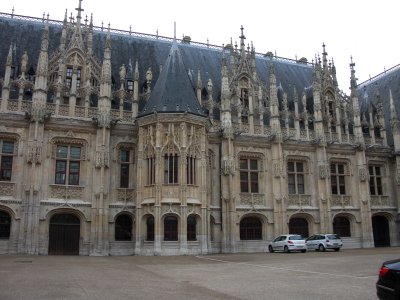 Tuesday morning, the taxi came, as scheduled, at 9:45, and whisked (well, crept) us to the Gare St. Lazare in the 20 minutes Google said it should take, where we caught the 10:50 a.m. to Rouen. The last time we were here, in 2000, we arrived by car, our last stop before heading back to Paris after a tour of Normandy, and the traffic pattern proved to be a nightmare. Our hotel was in the dead center of the whirlpool of one-way streets—you had to spiral all the way into the middle of town to reverse direction and spiral back out. This time, we had a hotel right down by the river, within three blocks of both our restaurants, the cathedral, and the Office de Tourisme, and we didn't pick up our rental car until we left town.
Tuesday morning, the taxi came, as scheduled, at 9:45, and whisked (well, crept) us to the Gare St. Lazare in the 20 minutes Google said it should take, where we caught the 10:50 a.m. to Rouen. The last time we were here, in 2000, we arrived by car, our last stop before heading back to Paris after a tour of Normandy, and the traffic pattern proved to be a nightmare. Our hotel was in the dead center of the whirlpool of one-way streets—you had to spiral all the way into the middle of town to reverse direction and spiral back out. This time, we had a hotel right down by the river, within three blocks of both our restaurants, the cathedral, and the Office de Tourisme, and we didn't pick up our rental car until we left town.
I poked around a little on the net in Paris, to find out what the touristic possibilities were, and discovered that the oldest monument to Judaism in France is a yeshiva discovered under the courtyard of the Palais de Justice (part of its courtyard and elaborate, gargoyle-infested façade shown here) during renovation excavations. It could be visited only once a week, during a tour conducted at 3 p.m. on Tuesdays!
So, after our noon arrival and a quick taxi ride to our hotel, where we dropped the luggage, we hastened to the Office de Tourism to sign up, only to find that the tour was already solidly booked up. So much for that—we'll only be here two days.
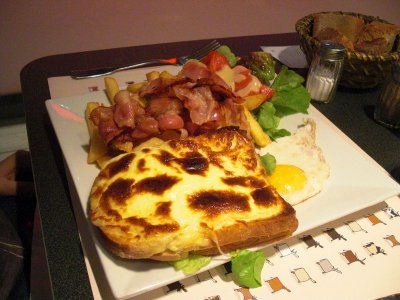
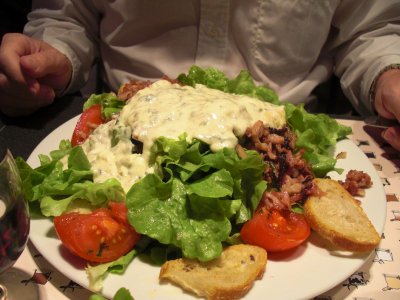 Lunch, then. We circled the Place du Cathédrale, reading menus, and settled at the "Al'1," which turned out to be such a find that we went back again the next day.
Lunch, then. We circled the Place du Cathédrale, reading menus, and settled at the "Al'1," which turned out to be such a find that we went back again the next day.
CJ ordered the croque-monsieur, which came with a fried egg and a heap of European-style bacon that almost hid the heap of fries.
David had the salade Auvergnate again, and this one was not only huge but buried under a veritable lava-flow of melted blue cheese (covering about 1/3 lb lardons).
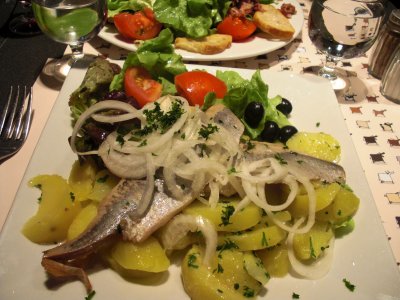
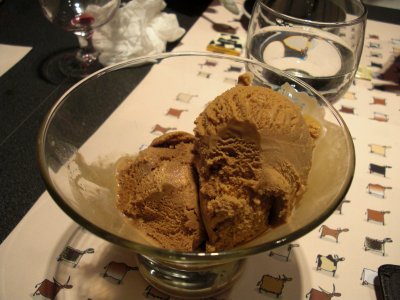 I finally took the opportunity to order something I'd been seeing on menus for days—marinated herring with warm potato salad, showered with sweet raw onion. Delicious, though I could not persuade my companions to agree.
I finally took the opportunity to order something I'd been seeing on menus for days—marinated herring with warm potato salad, showered with sweet raw onion. Delicious, though I could not persuade my companions to agree.
While they had coffee, I resisted the temptations of a café Liègeois, coupe Parisien (vanilla ice cream, cream of chestnuts, and whipped cream), and coupe iceberg (chocolate-chip mint ice cream with whipped cream and mint liqueur) and settled for two scoops of ice cream, one coffee and one salted caramel. As you can see, they weren't easy to tell apart on sight.
Despite a list of over a dozen guided walking tours listed on the "tourisme Rouen" website, nothing was available the days we were in town except the self-guided tour with audioguide (the tours apparently only function in July and August, official French vacation season). Rather than start the audioguided tour so late in the day, we just crossed the square to visit the cathedral freestyle.
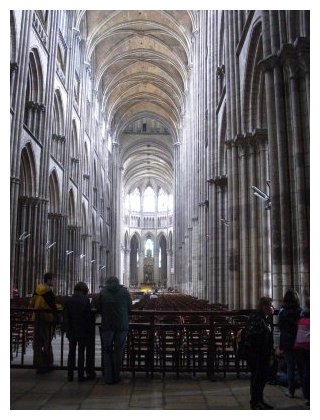
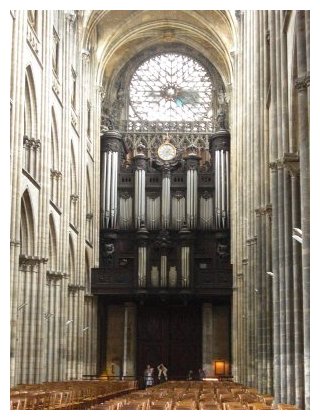
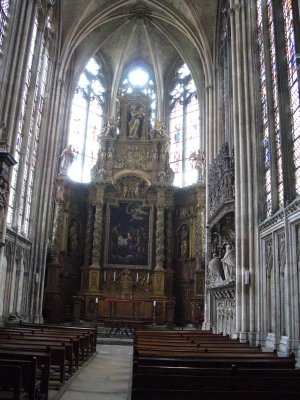 Here are the usual views, left to right: The view down the nave toward the apse, the view in the other direction up the nave toward the organ and rose window in the back, and the unusually deep lady chapel behind the altar.
Here are the usual views, left to right: The view down the nave toward the apse, the view in the other direction up the nave toward the organ and rose window in the back, and the unusually deep lady chapel behind the altar.
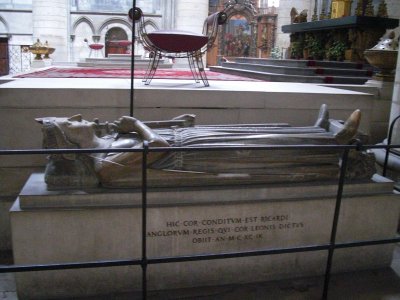
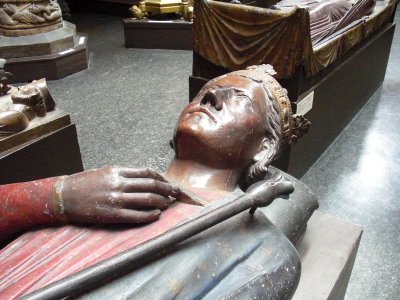 The cathedral houses "gisants" (reclining tomb figures) of four monarchs. At the left is Richard I, the Lion-Hearted. Only his heart is actually buried in Rouen Cathedral, but the gisant represents all of him for good measure. At the right is a photo of the plaster cast of that gisant, which I took 8 days earlier in the cast court of the Victoria and Albert Museum in London. Good resemblance. I don't know how they finish the plaster to look so old and so like the original.
The cathedral houses "gisants" (reclining tomb figures) of four monarchs. At the left is Richard I, the Lion-Hearted. Only his heart is actually buried in Rouen Cathedral, but the gisant represents all of him for good measure. At the right is a photo of the plaster cast of that gisant, which I took 8 days earlier in the cast court of the Victoria and Albert Museum in London. Good resemblance. I don't know how they finish the plaster to look so old and so like the original.
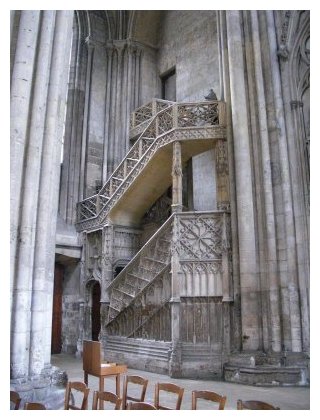
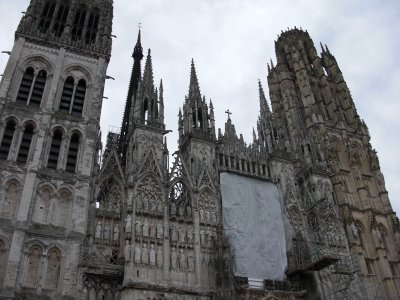 The other three figures are of Richard's older brother, Henry the Younger, eldest son of Henry II (not technically a monarch, since he died before his father did, leaving Richard heir to the throne); Rollo, the viking who conquered Rouen, settled there, converted to Christianity, and founded the dynasty that (a few generations later) produced William the Conquerer; and Rollo's son, benefactor of Jumiège Abbey, which we visited a couple of days later.
The other three figures are of Richard's older brother, Henry the Younger, eldest son of Henry II (not technically a monarch, since he died before his father did, leaving Richard heir to the throne); Rollo, the viking who conquered Rouen, settled there, converted to Christianity, and founded the dynasty that (a few generations later) produced William the Conquerer; and Rollo's son, benefactor of Jumiège Abbey, which we visited a couple of days later.
At the left is a photo of the beautiful stone staircase in the left side aisle that led to the monks' library. We asked whether we could tour the crypt, but no, those tours are only on weekends until July and August (official French vacation season).
While CJ and I were wandering the cathedral, David attached himself to a fifth-grade class who were touring the place with their teachers. He said it was great—the explanations were in fifth-grade French, which he found easy to follow, and he learned a bunch about the cathedral.
At the right is an attempt at photographing the cathedral's façade (the draped section in the center is being cleaned). Unfortunately, you can't back up far enough to get all of it into one shot without bumping into the building housing the Office de Tourisme and, on the second floor, the room Claude Monet rented for months while he painted 28 versions of that façade. The spire with the weather vane on top is actually much taller than either tower, but the parallax conceals that difference.
Written 16 June 2012
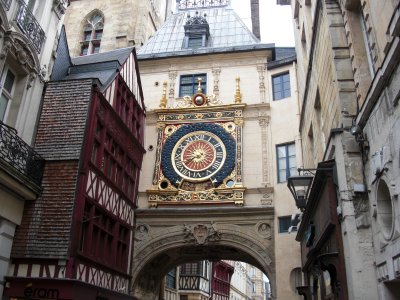
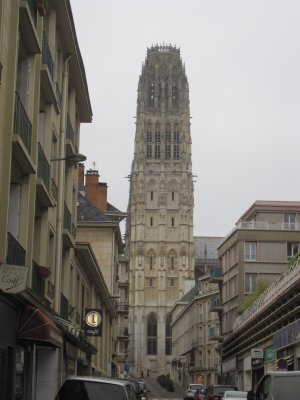 Later, on our way to dinner, David was able to get this shot of the full height of the south face of the south tower (the one on the right as you face the façade) by shooting up a side street from down by the banks of the Seine.
Later, on our way to dinner, David was able to get this shot of the full height of the south face of the south tower (the one on the right as you face the façade) by shooting up a side street from down by the banks of the Seine.
On the right is one side of the double-faced Gros Horloge (big clock), an important symbol of civil (as opposed to church) authority that could be granted only by the king. Up until permission was granted (rather earlier for Rouen than for the average city), only the church had the authority to ring the hours. Permission was later revoked, then granted again, at which point this large clock was constructed. The arch below it spans a street (now restricted to pedestrian traffic, like a lot of old-town Rouen).
At the bottom of the dial is a little window that rotates to show a different image each day. It was almost noon when I took the photo, but I couldn't get the others to stand around long enough to watch it change, and I had to agree that at the time lunch sounded very good.
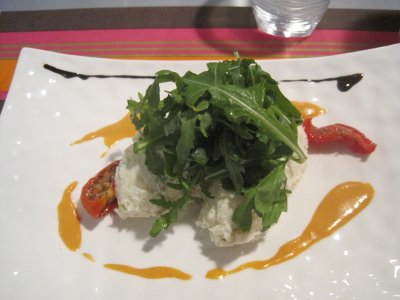
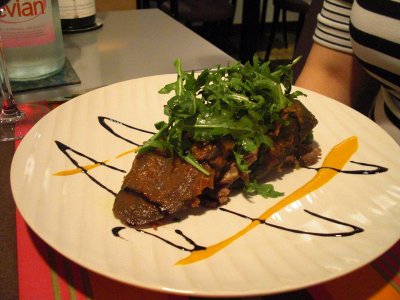 Dinner was at "le 37" (named for its street address), which Gault-Millau rate 2 out of 5.
Dinner was at "le 37" (named for its street address), which Gault-Millau rate 2 out of 5.
Amuse-bouche, two colors of olives, warm cheese shortbread cookies, and a bowl of those commercially available crispy freeze-dried veggie chips. As usual, the beet and sweet potato ones were the best.
First course, David: "Brandade de morue," a sort of cold hash/purée of potato and dried salt cod. The red objects are small, marinated house-dried tomatoes, which turned up on several plates and were excellent.
First course, CJ: A slice from a cold layered loaf of beef pot roast and eggplant. Also excellent.
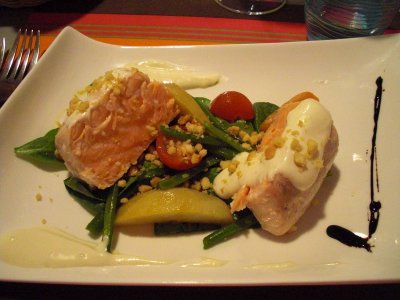
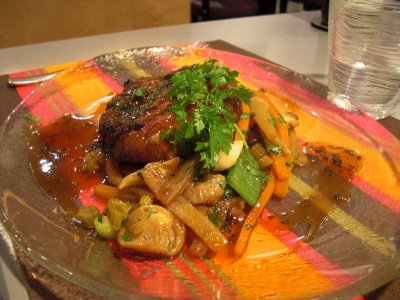 First course, me: Cold poached salmon with its "aioli de legumes," an upscale play on a dish served hot or cold in bistros in fishing ports, usually consisting of boiled cod (fresh or dried), vegetables, and a fierce garlic-based mayo. This aioli here was milder and tinged with lemon.
First course, me: Cold poached salmon with its "aioli de legumes," an upscale play on a dish served hot or cold in bistros in fishing ports, usually consisting of boiled cod (fresh or dried), vegetables, and a fierce garlic-based mayo. This aioli here was milder and tinged with lemon.
Main course, David: Chine of pork, boned, rolled, and roasted, then glazed with a rich meat reduction. It came on a bed of braised root vegetables that included celery root, carrot, onion, radish, and snow peas.
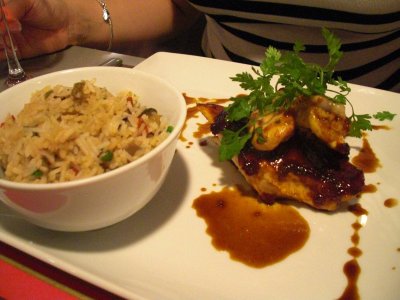
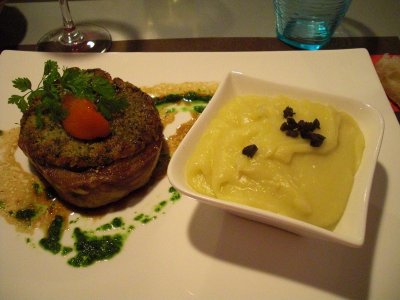 Main course, CJ: Breast of chicken roasted with tandoori spices, which she pronounced delicious. The rice pilaf served on the side was also slightly "Indian" flavored.
Main course, CJ: Breast of chicken roasted with tandoori spices, which she pronounced delicious. The rice pilaf served on the side was also slightly "Indian" flavored.
Main course, me: Breast of veal breast boned, rolled, covered with a bread-and-ground-veal stuffing, and roasted. On the side, I got a dish of silken olive-oil mashed potatoes sprinkled with chopped olive. Both outstanding. CJ started the trip under the impression she was not fond of veal or pork, but she now concedes that much depends on the preparation!
With these dishes, David and CJ drank an Aloxe-Corton, vielles vignes, 2009 "Domaine Gaston and Pierre Ravalt" that they positively swooned over. They're drinking a lot of Burgundies on this trip because the prices are good (a relative term) and because the selection, and especially the condition, of the wines is so much better than in the U.S.
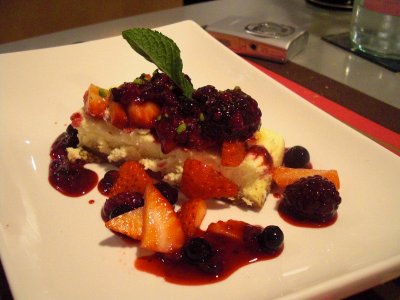
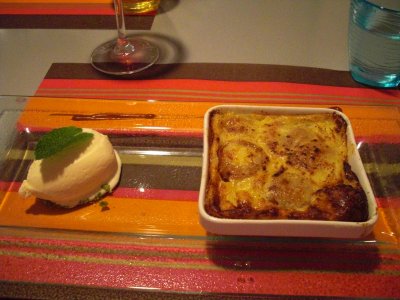 Dessert, David and CJ: Cheesecake made with French "fromage blanc" rather than cream cheese, doused with fresh fruit. The chef obligingly left the pistachio sprinkles off CJ's portion.
Dessert, David and CJ: Cheesecake made with French "fromage blanc" rather than cream cheese, doused with fresh fruit. The chef obligingly left the pistachio sprinkles off CJ's portion.
Dessert, me: Apricot clafoutis. The chef deployed fresh apricot halves in a deep dish, covered them with a mixure of egg, milk, a little flour, and lots of fresh vanilla seeds, then baked the whole thing. Vanilla ice cream on the side. Not the equal of the amazing cherry clafoutis we had in Lyon, but darned good nonetheless.
previous entry
List of Entries
next entry
 Tuesday morning, the taxi came, as scheduled, at 9:45, and whisked (well, crept) us to the Gare St. Lazare in the 20 minutes Google said it should take, where we caught the 10:50 a.m. to Rouen. The last time we were here, in 2000, we arrived by car, our last stop before heading back to Paris after a tour of Normandy, and the traffic pattern proved to be a nightmare. Our hotel was in the dead center of the whirlpool of one-way streets—you had to spiral all the way into the middle of town to reverse direction and spiral back out. This time, we had a hotel right down by the river, within three blocks of both our restaurants, the cathedral, and the Office de Tourisme, and we didn't pick up our rental car until we left town.
Tuesday morning, the taxi came, as scheduled, at 9:45, and whisked (well, crept) us to the Gare St. Lazare in the 20 minutes Google said it should take, where we caught the 10:50 a.m. to Rouen. The last time we were here, in 2000, we arrived by car, our last stop before heading back to Paris after a tour of Normandy, and the traffic pattern proved to be a nightmare. Our hotel was in the dead center of the whirlpool of one-way streets—you had to spiral all the way into the middle of town to reverse direction and spiral back out. This time, we had a hotel right down by the river, within three blocks of both our restaurants, the cathedral, and the Office de Tourisme, and we didn't pick up our rental car until we left town.
 Lunch, then. We circled the Place du Cathédrale, reading menus, and settled at the "Al'1," which turned out to be such a find that we went back again the next day.
Lunch, then. We circled the Place du Cathédrale, reading menus, and settled at the "Al'1," which turned out to be such a find that we went back again the next day.
 I finally took the opportunity to order something I'd been seeing on menus for days—marinated herring with warm potato salad, showered with sweet raw onion. Delicious, though I could not persuade my companions to agree.
I finally took the opportunity to order something I'd been seeing on menus for days—marinated herring with warm potato salad, showered with sweet raw onion. Delicious, though I could not persuade my companions to agree.

 Here are the usual views, left to right: The view down the nave toward the apse, the view in the other direction up the nave toward the organ and rose window in the back, and the unusually deep lady chapel behind the altar.
Here are the usual views, left to right: The view down the nave toward the apse, the view in the other direction up the nave toward the organ and rose window in the back, and the unusually deep lady chapel behind the altar.
 The cathedral houses "gisants" (reclining tomb figures) of four monarchs. At the left is Richard I, the Lion-Hearted. Only his heart is actually buried in Rouen Cathedral, but the gisant represents all of him for good measure. At the right is a photo of the plaster cast of that gisant, which I took 8 days earlier in the cast court of the Victoria and Albert Museum in London. Good resemblance. I don't know how they finish the plaster to look so old and so like the original.
The cathedral houses "gisants" (reclining tomb figures) of four monarchs. At the left is Richard I, the Lion-Hearted. Only his heart is actually buried in Rouen Cathedral, but the gisant represents all of him for good measure. At the right is a photo of the plaster cast of that gisant, which I took 8 days earlier in the cast court of the Victoria and Albert Museum in London. Good resemblance. I don't know how they finish the plaster to look so old and so like the original.
 The other three figures are of Richard's older brother, Henry the Younger, eldest son of Henry II (not technically a monarch, since he died before his father did, leaving Richard heir to the throne); Rollo, the viking who conquered Rouen, settled there, converted to Christianity, and founded the dynasty that (a few generations later) produced William the Conquerer; and Rollo's son, benefactor of Jumiège Abbey, which we visited a couple of days later.
The other three figures are of Richard's older brother, Henry the Younger, eldest son of Henry II (not technically a monarch, since he died before his father did, leaving Richard heir to the throne); Rollo, the viking who conquered Rouen, settled there, converted to Christianity, and founded the dynasty that (a few generations later) produced William the Conquerer; and Rollo's son, benefactor of Jumiège Abbey, which we visited a couple of days later. 
 Later, on our way to dinner, David was able to get this shot of the full height of the south face of the south tower (the one on the right as you face the façade) by shooting up a side street from down by the banks of the Seine.
Later, on our way to dinner, David was able to get this shot of the full height of the south face of the south tower (the one on the right as you face the façade) by shooting up a side street from down by the banks of the Seine.
 Dinner was at "le 37" (named for its street address), which Gault-Millau rate 2 out of 5.
Dinner was at "le 37" (named for its street address), which Gault-Millau rate 2 out of 5. 
 First course, me: Cold poached salmon with its "aioli de legumes," an upscale play on a dish served hot or cold in bistros in fishing ports, usually consisting of boiled cod (fresh or dried), vegetables, and a fierce garlic-based mayo. This aioli here was milder and tinged with lemon.
First course, me: Cold poached salmon with its "aioli de legumes," an upscale play on a dish served hot or cold in bistros in fishing ports, usually consisting of boiled cod (fresh or dried), vegetables, and a fierce garlic-based mayo. This aioli here was milder and tinged with lemon.
 Main course, CJ: Breast of chicken roasted with tandoori spices, which she pronounced delicious. The rice pilaf served on the side was also slightly "Indian" flavored.
Main course, CJ: Breast of chicken roasted with tandoori spices, which she pronounced delicious. The rice pilaf served on the side was also slightly "Indian" flavored.
 Dessert, David and CJ: Cheesecake made with French "fromage blanc" rather than cream cheese, doused with fresh fruit. The chef obligingly left the pistachio sprinkles off CJ's portion.
Dessert, David and CJ: Cheesecake made with French "fromage blanc" rather than cream cheese, doused with fresh fruit. The chef obligingly left the pistachio sprinkles off CJ's portion.